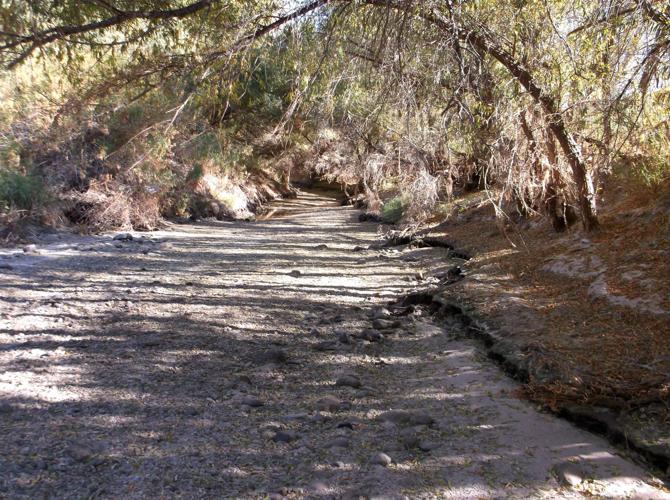Up to 1,000 non-native fish died in the Lower Santa Cruz River, a retired fish biologist says, because a state contractor diverted river water for an Ina Road bridge construction project.
The diversion moved the river’s treated sewage effluent from the west bank to the east bank, away from the towering, shady willow trees along the west bank. It ended Friday, a little more than a week after it started, when the contractor dug a new channel near the bridge site to reverse the effluent’s course back to the west bank.
The diversion “was a necessary part of the construction,” Arizona Department of Transportation spokesman Tim Tait said.
Fish biologist Bill Zook, who lives near the area, photographed dozens of the dead fish, which included mosquitofish, carp and catfish, and said he counted close to 1,000.
He said he saw people taking some fish out of that stretch of river and putting them in buckets to carry them to wetter areas downstream. He saw live fish struggling to survive in small pools left behind after the river water was diverted, along with a number of small turtles struggling in a tiny pool that was also crowded with carp, Zook said.
“They dewatered an area a little more than a mile long. It’s the most unique aquatic habitat in Tucson, a channel that everyone enjoyed,” said Zook, who bikes that river stretch daily on the Pima County Loop bike path after working 46 years as a fisheries biologist, including for Washington state and for the Pacific States Marine Fishers Commission.
The diversion was always designed to be short-term, said Tait, emphasizing also that the dead fish were all non-native.
But he said ADOT’s decision to reverse the river diversion was “accelerated” by questions from the Star and after Pima County officials issued a news release about the fish Thursday when residents began calling them.
“We had staff who went out there earlier this week, and we were getting stopped by everyone who went by, wanting to know what was happening with the river,” said Mark Evans, a county government spokesman. “It’s an unfortunate result that aquatic life is affected by flow diversions, but this is a channeled river. We have to do work on it, from time to time.
“There’s no practical way to move aquatic life with the water. There’s no other way to do it. We wish there were.”
The bridge project will replace an aging, two-lane structure with two new two-lane structures. It’s part of a $128 million-plus state project to overhaul the Ina Road interchange at Interstate 10, including the construction of a new bridge carrying Ina over the freeway and the railroad tracks to the east. One of the new, two-lane bridge structures is nearly completed.
Zook said he believed the diversion could have been reversed earlier, by having contractors use a backhoe to dig an opening, farther downstream of the bridge, through a berm separating the river’s west side from the east side.
The fish losses came two months after the Sonoran Institute released its latest “Living River” report about the Lower Santa Cruz. The report pointed to an increased number of non-native fish as a sign that the river’s water quality has improved since Pima County finished a major upgrade of its two big sewage treatment plants along the river in 2013. Biologists have found five non-native fish species in that river stretch since 2015, compared to one before the sewage plants were upgraded, the report said.
In a broad, ecological sense, the fish deaths weren’t that important, partly because a decent number of living fish have recently been found downstream of that area, said Claire Zugmeyer, an ecologist for the Sonoran Institute’s Living Rivers program, which has monitored the river’s health for five years.
“There’s still a good number of fish. We might lose some, but in the grand scheme of things it’s not too many,” Zugmeyer said.
Watching dead fish float by was sad, nonetheless, said Marana resident Nancy Prevedello, as she walked downstream Friday morning along the Loop on the river’s west bank with her 6-year-old son. “It’s just terrible,” she said.





